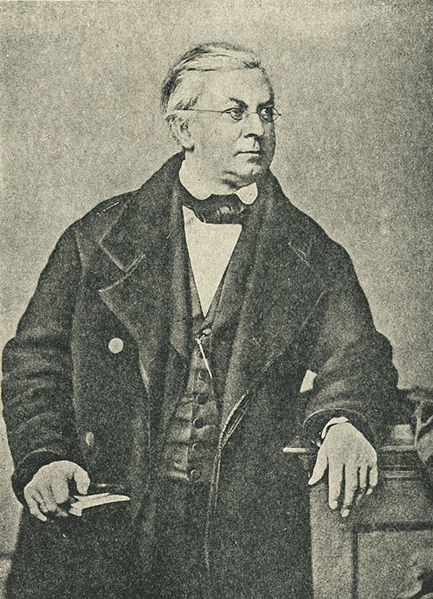<Back to Index>
- Physiologist Karl Theodor Ernst von Siebold, 1804
- Engraver Giambattista Bodoni, 1740
- Admiral Gaspard de Coligny, 1519
PAGE SPONSOR

Karl (Carl) Theodor Ernst von Siebold (February 16, 1804 - April 7, 1885) was a German physiologist and zoologist. He was responsible for the introduction of the taxa Arthropoda and Rhizopoda, and for defining the taxon Protozoa specifically for single celled organisms.
He was born at Würzburg, Bavaria, the son of a professor of obstetrics and a cousin (some say younger brother) to the naturalist and physician Philipp Franz von Siebold. Von Siebold studied medicine and science chiefly at the University of Berlin (under K. A. Rudolphi) and also at Göttingen (under Johann Friedrich Blumenbach), submitting a thesis on the metamorphosis of the salamander. In 1831 he began to practice medicine in Heilsberg, East Prussia (now Lidzbark Warmiński), moving in 1834 to Königsberg, and then in the same year to be Director of the Hebammenschule in Danzig.
He became professor of zoology, comparative anatomy and veterinary science at Erlangen in 1840, professor of zoology and physiology at Freiburg in 1845, professor of physiology at Breslau in 1850, and professor of zoology and comparative anatomy at the Maximilians - Universität in Munich in 1853. In Munich, he later received the additional duties as professor of zoology and director of the zoological and zootomical cabinet.
He was elected a member of the Royal Swedish Academy of Sciences in 1856.
He
died in Munich on
7
April 1885. He was considered “an industrious and
critical observer
and ... as his biographer justly calls him, the Nestor
of German
zoology” (quote from 1911 Encyclopædia
Britannica).
His best known publication was the Lehrbuch der Vergleichenden Anatomie (Manual of Comparative Anatomy) (1845 - 48) which he co-edited with Hermann Friedrich Stannius, being largely responsible for the first volume, on invertebrates. Siebold was the originator, after Cuvier, of the first important reforms in systematic zoology, and established the unicellular nature of the Protozoa, which he first combined into a phylum. He introduced the taxa Arthropoda and Rhizopoda. In 1848, together with R.A. von Kölliker he founded the leading biological journal Zeitschrift für wissenschaftliche Zoologie, which he edited until his death. This was long the leading morphological and anatomical journal of Europe.
His scientific accomplishments included (in 1851) collaborating with Theodor Bilharz on the first description of the blood fluke Schistosoma haematobium, (in 1853) the elucidation of the life cycle of the tapeworm Echinococcus granulosus, (in 1854) the suggestion that the cercariae of the fluke Fasciola hepatica were the infective stage which passed from the invertebrate to the vertebrate host, and (in 1856) the discovery of parthenogenesis in insects. He also published work on medusae, other cestodes and trematodes, and strepsipterans...
His collection of worm specimens was purchased for the Helminth Collection of the Natural History Museum in London in 1851. His fish collection (1804 - 1855), specializing in freshwater fishes of Bavaria, was deposited at the Zoological Cabinet of the Bavarian State in 1863, and though most were lost in WWII, some specimens remain at the Zoologische Staatssammlung in Munich.